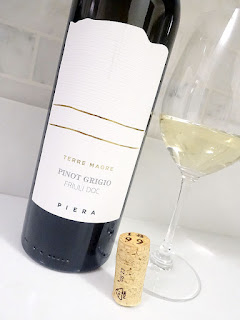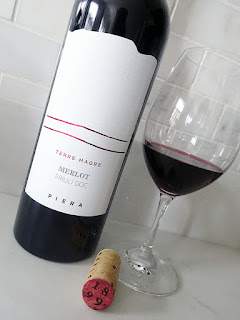white wine review is one of my favourite Chardonnays from Argentina. While the printed magazine specifies the 2020 vintage, in actuality it was the 2022 vintage that arrived at the LCBO earlier this month as part of the theme on Fine Wines for Festive Entertaining in the LCBO VINTAGES New Release Collection on .
It is produced by El Enemigo Wines, a passion project that was established in 2008 by two friends - highly-acclaimed winemaker Alejandro Vigil and historian Adrianna Catena. Alejandro is a soil expert who has been with Bodega Catena Zapata as their chief winemaker for more than 20 years, while Adrianna is the younger sister of Dr. Laura Catena, as well as the youngest daughter of legend Nicolas Catena, of the famed Catena family of Argentina.
The name "El Enemigo" means "the enemy", and was inspired by Dante Alighieri's poem "The Divine Comedy". The credo behind the name is the struggle that most defines us in our lives is the one we wage with ourselves - we are our own worst enemy. The philosophy is to embrace the "enemy" or challenges in winemaking, confronting the difficulties and turning them into opportunities for creating exceptional wines.
Today, El Enemigo is situated among the high-altitude vineyards in the Uco Valley and has gained a reputation for producing some of Argentina's finest wines. The wines of El Enemigo are enigmatic, charismatic, and verging on iconoclastic, and in a way they reflect their maker, Alejandro, with an almost Picasso-like personality. While he consults and contributes academic research on soils and microbial composition, with El Enemigo he plays and expresses himself creatively. At the same time, the wines of El Enemigo are sensitive to historical blends and traditions as some of the grapes come from some of the oldest vineyard sites in the region.
Like the 2018 El Enemigo Chardonnay that I enjoyed last year, this vintage was also grown in the region of Gualtallary, within the Tupungato district in the northern reaches of the Uco Valley, at a high-altitude of 1,470 metres (4,822 feet) above sea level on deep-calcareous and rocky soil. It was fermented using wild yeast in 500 L French oak barrels, with 35% new barrels, followed by ageing under veil (flor yeast) for 12 months in 500 L French oak barrels.
The 2022 growing season delivered another successful harvest, although the year did have its challenges. In Mendoza, the region began with a cool, dry spring, as well as little snowfall, which resulted in less water flowing down to a region already suffering from severe water shortages. Further challenges arrived when five frosts, some severe, occurred between October and November in the Uco Valley. The white grape varieties were a big challenge due to rain that arrived at the end of spring, between December and February, and was concentrated to a few weeks. However, if the harvest was done well, good quality with fresher wines is achieved. Let's see how this 2022 Chardonnay from Argentina is tasting tonight...
Using wild yeast, this was fermented and aged in French oak barrels. The fragrant, medium-high intensity nose is ripe and appealing with pineapple, banana, citrus, caramel, toffee, butter, and leesy flor aromas. It's mid-weighted with good concentration, well-structured, sweet fruited, yet dry, with delicious banana, pineapple, lemon citrus, apple, toffee/caramel, leesy flor, and buttery flavours in a complex profile with all vying for attention. Acids are crisp and fresh, plus a touch of spice notes on the mid-palate. The long finish is dry with lingering notes of smoke and mineral. Enjoy this highly recommended buy over the next 4-5 years. Score: 92 pts
Other lovely wines by El Enemigo can found at the LCBO or through their Agent - Noble Estates Wine & Spirits.
It is produced by El Enemigo Wines, a passion project that was established in 2008 by two friends - highly-acclaimed winemaker Alejandro Vigil and historian Adrianna Catena. Alejandro is a soil expert who has been with Bodega Catena Zapata as their chief winemaker for more than 20 years, while Adrianna is the younger sister of Dr. Laura Catena, as well as the youngest daughter of legend Nicolas Catena, of the famed Catena family of Argentina.
The name "El Enemigo" means "the enemy", and was inspired by Dante Alighieri's poem "The Divine Comedy". The credo behind the name is the struggle that most defines us in our lives is the one we wage with ourselves - we are our own worst enemy. The philosophy is to embrace the "enemy" or challenges in winemaking, confronting the difficulties and turning them into opportunities for creating exceptional wines.
Today, El Enemigo is situated among the high-altitude vineyards in the Uco Valley and has gained a reputation for producing some of Argentina's finest wines. The wines of El Enemigo are enigmatic, charismatic, and verging on iconoclastic, and in a way they reflect their maker, Alejandro, with an almost Picasso-like personality. While he consults and contributes academic research on soils and microbial composition, with El Enemigo he plays and expresses himself creatively. At the same time, the wines of El Enemigo are sensitive to historical blends and traditions as some of the grapes come from some of the oldest vineyard sites in the region.
Like the 2018 El Enemigo Chardonnay that I enjoyed last year, this vintage was also grown in the region of Gualtallary, within the Tupungato district in the northern reaches of the Uco Valley, at a high-altitude of 1,470 metres (4,822 feet) above sea level on deep-calcareous and rocky soil. It was fermented using wild yeast in 500 L French oak barrels, with 35% new barrels, followed by ageing under veil (flor yeast) for 12 months in 500 L French oak barrels.
The 2022 growing season delivered another successful harvest, although the year did have its challenges. In Mendoza, the region began with a cool, dry spring, as well as little snowfall, which resulted in less water flowing down to a region already suffering from severe water shortages. Further challenges arrived when five frosts, some severe, occurred between October and November in the Uco Valley. The white grape varieties were a big challenge due to rain that arrived at the end of spring, between December and February, and was concentrated to a few weeks. However, if the harvest was done well, good quality with fresher wines is achieved. Let's see how this 2022 Chardonnay from Argentina is tasting tonight...
Tasting Note:
EL ENEMIGO CHARDONNAY 2022 - Mendoza, Argentina (#482984) (XD) - $25.95Using wild yeast, this was fermented and aged in French oak barrels. The fragrant, medium-high intensity nose is ripe and appealing with pineapple, banana, citrus, caramel, toffee, butter, and leesy flor aromas. It's mid-weighted with good concentration, well-structured, sweet fruited, yet dry, with delicious banana, pineapple, lemon citrus, apple, toffee/caramel, leesy flor, and buttery flavours in a complex profile with all vying for attention. Acids are crisp and fresh, plus a touch of spice notes on the mid-palate. The long finish is dry with lingering notes of smoke and mineral. Enjoy this highly recommended buy over the next 4-5 years. Score: 92 pts
Other lovely wines by El Enemigo can found at the LCBO or through their Agent - Noble Estates Wine & Spirits.






















